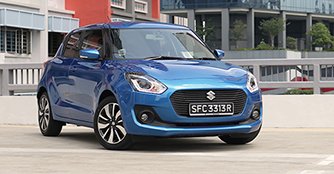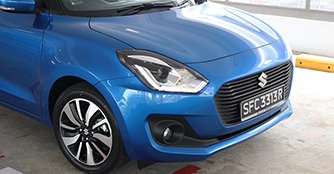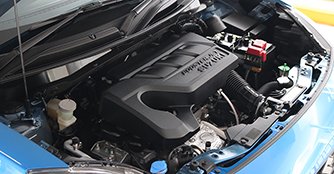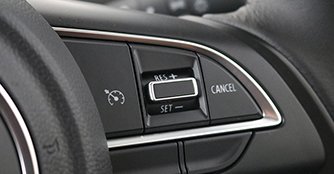Suzuki Swift 1.0 (A) Review
10 Aug 2018|38,524 views
What We Like
Perky 1.0-litre engine
Cabin feels well built
Bigger boot than before
Eager and excitable handling
Fun to drive
Cheery personality
What We Dislike
Road noise is very apparent
Transmission in M setting doesn't give you full control
A lot of competitive alternatives in the market
The Suzuki Swift is a car that many enthusiasts will have fond memories of. Since it first arrived on our shores in 2004, the Swift has delighted drivers with its compact footprint, eager handling and playful nature. We'd be remiss to not also mention that the Swift was likely the first car for many car modding enthusiasts, too.
Now, the Swift returns in its third iteration, with a host of changes that begs the question - is this still the eager beaver hatchback that we all fondly remember it to be?
It looks familiar, but different...
Visually, while the Swift generally retains the same iconic bodyshape, the new car definitely looks sharper, most notably at the front. On either side of the new front grille, you will find LED headlamps with LED daytime running lights. And at the rear, there are LED tail lamps as well.
Compared to its predecessor, the new Swift is 10mm shorter in overall length, but actually gains a 20mm longer wheelbase, now measuring 2,450mm. Also, the Swift sits a little shorter (1,495mm in height), but is now wider than before, at 1,735mm wide.
In fact, because this is the export model, it is wider than the car available from parallel importers. This is because those domestic market cars are only 1,695mm wide, to conform to Japanese regulations.
Is it still cheap inside?
The Suzuki brand has always been about modest affordability, so don't expect too many miracles inside the cabin. It's still a fairly modest cabin, with lots of plastics. Equipment levels are reasonable enough - you've got modern features like automatic air-conditioning and a multi-information LCD display in the instrument cluster, but that is somewhat offset by the head unit in the centre console that looks like it was from five years ago.
However, we are impressed with the improved refinement and build quality inside the Swift. Yes, the materials may not be necessarily that expensive, but it all feels well built. We particularly liked the way the indicator stalk feels - it's chunky and well-damped, and clicks into place in very tactile and satisfying manner.
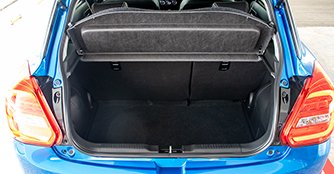
 The 264-litre boot is a 54-litre improvement from before, adding an extra dose of practicality to a car
The 264-litre boot is a 54-litre improvement from before, adding an extra dose of practicality to a car
It's also a tad more spacious at the back, thanks to the 20mm longer wheelbase, but there's no getting around the fact that this is still a small car.
How's that new turbocharged engine?
The big news is the powertrain - a turbocharged three-cylinder 1.0-litre Boosterjet engine that now motivates the Swift. It is brisk enough, with 109bhp and 160Nm of torque, and propels the 940kg Swift with more gusto than you may expect. Power is also delivered in a reasonably smooth manner.
Now, the Swift returns in its third iteration, with a host of changes that begs the question - is this still the eager beaver hatchback that we all fondly remember it to be?
It looks familiar, but different...
Visually, while the Swift generally retains the same iconic bodyshape, the new car definitely looks sharper, most notably at the front. On either side of the new front grille, you will find LED headlamps with LED daytime running lights. And at the rear, there are LED tail lamps as well.
Compared to its predecessor, the new Swift is 10mm shorter in overall length, but actually gains a 20mm longer wheelbase, now measuring 2,450mm. Also, the Swift sits a little shorter (1,495mm in height), but is now wider than before, at 1,735mm wide.
In fact, because this is the export model, it is wider than the car available from parallel importers. This is because those domestic market cars are only 1,695mm wide, to conform to Japanese regulations.
Is it still cheap inside?
The Suzuki brand has always been about modest affordability, so don't expect too many miracles inside the cabin. It's still a fairly modest cabin, with lots of plastics. Equipment levels are reasonable enough - you've got modern features like automatic air-conditioning and a multi-information LCD display in the instrument cluster, but that is somewhat offset by the head unit in the centre console that looks like it was from five years ago.
However, we are impressed with the improved refinement and build quality inside the Swift. Yes, the materials may not be necessarily that expensive, but it all feels well built. We particularly liked the way the indicator stalk feels - it's chunky and well-damped, and clicks into place in very tactile and satisfying manner.

It's also a tad more spacious at the back, thanks to the 20mm longer wheelbase, but there's no getting around the fact that this is still a small car.
How's that new turbocharged engine?
The big news is the powertrain - a turbocharged three-cylinder 1.0-litre Boosterjet engine that now motivates the Swift. It is brisk enough, with 109bhp and 160Nm of torque, and propels the 940kg Swift with more gusto than you may expect. Power is also delivered in a reasonably smooth manner.
The engine is paired to a six-speed automatic gearbox - pretty satisfactory for normal driving, but less so when you want to push hard. Our main gripe is that even when you put the gear lever into 'M', the gearbox doesn't give you 100% control. Throttle hard and it will shift down to a lower gear - it's not wrong per se, but it does rob you of the sensation of being fully in control of your gearing choices.
The Swift has always been touted for it's excitable and eager handling, and the new one doesn't disappoint. Throw it into a few corners and this is abundantly clear. Carry extra speed into a corner, lift off the accelerator, and the car will let the tail loose.
There is one big caveat on the new Swift - the road noise is rather apparent. Regardless of what speed you are doing, whether 30km/h or 90km/h, road noise is always there. We suspect this is a combination of the tyres, as well as the reduction in noise insulating materials (hence the car's low kerb weight).
Is it a value proposition?
The biggest challenge the Swift faces is the fact that the car market has changed significantly since the model first launched here more than a decade ago. Back then, there were few competitors in its class (and the Swift was more affordable, too).
These days, the Swift comes up against stiff competition, with a wealth of new hatchback choices. The Honda Jazz RS, the Mazda 2 and the Seat Ibiza all clock in at the same sub-$90,000 price bracket. Additionally, there are also compact sedans in that price range offering more space and better equipment, such as the Hyundai Elantra and the Kia K3 Cerato.
Does the Swift punch above it's weight? No, we can't say it does. It's not the most refined, well-equipped or practical option, and buyers looking at these criteria will likely look elsewhere.
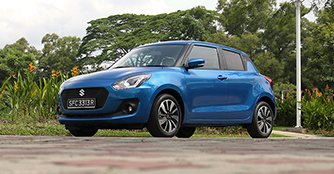
 The new Suzuki Swift harkens back to the days of modestly priced and modestly powered hatchbacks that delivered great amounts of fun and joy
The new Suzuki Swift harkens back to the days of modestly priced and modestly powered hatchbacks that delivered great amounts of fun and joy
What the new Suzuki Swift does is to punch exactly at its weight - it delivers a particular kind of experience that will delight drivers looking for a fun, personable and characterful compact hatchback. If you can stomach some of the car's shortcomings, the Swift is thoroughly fun and enjoyable to drive.
But more significantly, driving the Swift took us back to our younger days of chucking around a small and lively hatchback. It may not be the most practical, particularly refined or even that powerful, but those things don't really matter when you're enjoying yourself driving this playful little car, with a wide smile on your face.
The Swift has always been touted for it's excitable and eager handling, and the new one doesn't disappoint. Throw it into a few corners and this is abundantly clear. Carry extra speed into a corner, lift off the accelerator, and the car will let the tail loose.
There is one big caveat on the new Swift - the road noise is rather apparent. Regardless of what speed you are doing, whether 30km/h or 90km/h, road noise is always there. We suspect this is a combination of the tyres, as well as the reduction in noise insulating materials (hence the car's low kerb weight).
Is it a value proposition?
The biggest challenge the Swift faces is the fact that the car market has changed significantly since the model first launched here more than a decade ago. Back then, there were few competitors in its class (and the Swift was more affordable, too).
These days, the Swift comes up against stiff competition, with a wealth of new hatchback choices. The Honda Jazz RS, the Mazda 2 and the Seat Ibiza all clock in at the same sub-$90,000 price bracket. Additionally, there are also compact sedans in that price range offering more space and better equipment, such as the Hyundai Elantra and the Kia K3 Cerato.
Does the Swift punch above it's weight? No, we can't say it does. It's not the most refined, well-equipped or practical option, and buyers looking at these criteria will likely look elsewhere.

What the new Suzuki Swift does is to punch exactly at its weight - it delivers a particular kind of experience that will delight drivers looking for a fun, personable and characterful compact hatchback. If you can stomach some of the car's shortcomings, the Swift is thoroughly fun and enjoyable to drive.
But more significantly, driving the Swift took us back to our younger days of chucking around a small and lively hatchback. It may not be the most practical, particularly refined or even that powerful, but those things don't really matter when you're enjoying yourself driving this playful little car, with a wide smile on your face.
What We Like
Perky 1.0-litre engine
Cabin feels well built
Bigger boot than before
Eager and excitable handling
Fun to drive
Cheery personality
What We Dislike
Road noise is very apparent
Transmission in M setting doesn't give you full control
A lot of competitive alternatives in the market
The Suzuki Swift is a car that many enthusiasts will have fond memories of. Since it first arrived on our shores in 2004, the Swift has delighted drivers with its compact footprint, eager handling and playful nature. We'd be remiss to not also mention that the Swift was likely the first car for many car modding enthusiasts, too.
Now, the Swift returns in its third iteration, with a host of changes that begs the question - is this still the eager beaver hatchback that we all fondly remember it to be?
It looks familiar, but different...
Visually, while the Swift generally retains the same iconic bodyshape, the new car definitely looks sharper, most notably at the front. On either side of the new front grille, you will find LED headlamps with LED daytime running lights. And at the rear, there are LED tail lamps as well.
Compared to its predecessor, the new Swift is 10mm shorter in overall length, but actually gains a 20mm longer wheelbase, now measuring 2,450mm. Also, the Swift sits a little shorter (1,495mm in height), but is now wider than before, at 1,735mm wide.
In fact, because this is the export model, it is wider than the car available from parallel importers. This is because those domestic market cars are only 1,695mm wide, to conform to Japanese regulations.
Is it still cheap inside?
The Suzuki brand has always been about modest affordability, so don't expect too many miracles inside the cabin. It's still a fairly modest cabin, with lots of plastics. Equipment levels are reasonable enough - you've got modern features like automatic air-conditioning and a multi-information LCD display in the instrument cluster, but that is somewhat offset by the head unit in the centre console that looks like it was from five years ago.
However, we are impressed with the improved refinement and build quality inside the Swift. Yes, the materials may not be necessarily that expensive, but it all feels well built. We particularly liked the way the indicator stalk feels - it's chunky and well-damped, and clicks into place in very tactile and satisfying manner.

 The 264-litre boot is a 54-litre improvement from before, adding an extra dose of practicality to a carIt's also a tad more spacious at the back, thanks to the 20mm longer wheelbase, but there's no getting around the fact that this is still a small car.
The 264-litre boot is a 54-litre improvement from before, adding an extra dose of practicality to a carIt's also a tad more spacious at the back, thanks to the 20mm longer wheelbase, but there's no getting around the fact that this is still a small car.
How's that new turbocharged engine?
The big news is the powertrain - a turbocharged three-cylinder 1.0-litre Boosterjet engine that now motivates the Swift. It is brisk enough, with 109bhp and 160Nm of torque, and propels the 940kg Swift with more gusto than you may expect. Power is also delivered in a reasonably smooth manner.
Now, the Swift returns in its third iteration, with a host of changes that begs the question - is this still the eager beaver hatchback that we all fondly remember it to be?
It looks familiar, but different...
Visually, while the Swift generally retains the same iconic bodyshape, the new car definitely looks sharper, most notably at the front. On either side of the new front grille, you will find LED headlamps with LED daytime running lights. And at the rear, there are LED tail lamps as well.
Compared to its predecessor, the new Swift is 10mm shorter in overall length, but actually gains a 20mm longer wheelbase, now measuring 2,450mm. Also, the Swift sits a little shorter (1,495mm in height), but is now wider than before, at 1,735mm wide.
In fact, because this is the export model, it is wider than the car available from parallel importers. This is because those domestic market cars are only 1,695mm wide, to conform to Japanese regulations.
Is it still cheap inside?
The Suzuki brand has always been about modest affordability, so don't expect too many miracles inside the cabin. It's still a fairly modest cabin, with lots of plastics. Equipment levels are reasonable enough - you've got modern features like automatic air-conditioning and a multi-information LCD display in the instrument cluster, but that is somewhat offset by the head unit in the centre console that looks like it was from five years ago.
However, we are impressed with the improved refinement and build quality inside the Swift. Yes, the materials may not be necessarily that expensive, but it all feels well built. We particularly liked the way the indicator stalk feels - it's chunky and well-damped, and clicks into place in very tactile and satisfying manner.

How's that new turbocharged engine?
The big news is the powertrain - a turbocharged three-cylinder 1.0-litre Boosterjet engine that now motivates the Swift. It is brisk enough, with 109bhp and 160Nm of torque, and propels the 940kg Swift with more gusto than you may expect. Power is also delivered in a reasonably smooth manner.
The engine is paired to a six-speed automatic gearbox - pretty satisfactory for normal driving, but less so when you want to push hard. Our main gripe is that even when you put the gear lever into 'M', the gearbox doesn't give you 100% control. Throttle hard and it will shift down to a lower gear - it's not wrong per se, but it does rob you of the sensation of being fully in control of your gearing choices.
The Swift has always been touted for it's excitable and eager handling, and the new one doesn't disappoint. Throw it into a few corners and this is abundantly clear. Carry extra speed into a corner, lift off the accelerator, and the car will let the tail loose.
There is one big caveat on the new Swift - the road noise is rather apparent. Regardless of what speed you are doing, whether 30km/h or 90km/h, road noise is always there. We suspect this is a combination of the tyres, as well as the reduction in noise insulating materials (hence the car's low kerb weight).
Is it a value proposition?
The biggest challenge the Swift faces is the fact that the car market has changed significantly since the model first launched here more than a decade ago. Back then, there were few competitors in its class (and the Swift was more affordable, too).
These days, the Swift comes up against stiff competition, with a wealth of new hatchback choices. The Honda Jazz RS, the Mazda 2 and the Seat Ibiza all clock in at the same sub-$90,000 price bracket. Additionally, there are also compact sedans in that price range offering more space and better equipment, such as the Hyundai Elantra and the Kia K3 Cerato.
Does the Swift punch above it's weight? No, we can't say it does. It's not the most refined, well-equipped or practical option, and buyers looking at these criteria will likely look elsewhere.

 The new Suzuki Swift harkens back to the days of modestly priced and modestly powered hatchbacks that delivered great amounts of fun and joyWhat the new Suzuki Swift does is to punch exactly at its weight - it delivers a particular kind of experience that will delight drivers looking for a fun, personable and characterful compact hatchback. If you can stomach some of the car's shortcomings, the Swift is thoroughly fun and enjoyable to drive.
The new Suzuki Swift harkens back to the days of modestly priced and modestly powered hatchbacks that delivered great amounts of fun and joyWhat the new Suzuki Swift does is to punch exactly at its weight - it delivers a particular kind of experience that will delight drivers looking for a fun, personable and characterful compact hatchback. If you can stomach some of the car's shortcomings, the Swift is thoroughly fun and enjoyable to drive.
But more significantly, driving the Swift took us back to our younger days of chucking around a small and lively hatchback. It may not be the most practical, particularly refined or even that powerful, but those things don't really matter when you're enjoying yourself driving this playful little car, with a wide smile on your face.
The Swift has always been touted for it's excitable and eager handling, and the new one doesn't disappoint. Throw it into a few corners and this is abundantly clear. Carry extra speed into a corner, lift off the accelerator, and the car will let the tail loose.
There is one big caveat on the new Swift - the road noise is rather apparent. Regardless of what speed you are doing, whether 30km/h or 90km/h, road noise is always there. We suspect this is a combination of the tyres, as well as the reduction in noise insulating materials (hence the car's low kerb weight).
Is it a value proposition?
The biggest challenge the Swift faces is the fact that the car market has changed significantly since the model first launched here more than a decade ago. Back then, there were few competitors in its class (and the Swift was more affordable, too).
These days, the Swift comes up against stiff competition, with a wealth of new hatchback choices. The Honda Jazz RS, the Mazda 2 and the Seat Ibiza all clock in at the same sub-$90,000 price bracket. Additionally, there are also compact sedans in that price range offering more space and better equipment, such as the Hyundai Elantra and the Kia K3 Cerato.
Does the Swift punch above it's weight? No, we can't say it does. It's not the most refined, well-equipped or practical option, and buyers looking at these criteria will likely look elsewhere.

But more significantly, driving the Swift took us back to our younger days of chucking around a small and lively hatchback. It may not be the most practical, particularly refined or even that powerful, but those things don't really matter when you're enjoying yourself driving this playful little car, with a wide smile on your face.
Also read our comparison article on:
Honda Jazz 1.5 RS vs Seat Ibiza 1.0 EcoTSI DSG vs Suzuki Swift 1.0Car Information
Suzuki Swift 1.0 Turbo Standard (A)
CAT A|Petrol|17.5km/L
Horsepower
81kW (109 bhp)
Torque
160 Nm
Acceleration
10sec (0-100km /hr)
This model is no longer being sold by local distributor
All Used Suzuki SwiftThank You For Your Subscription.






















